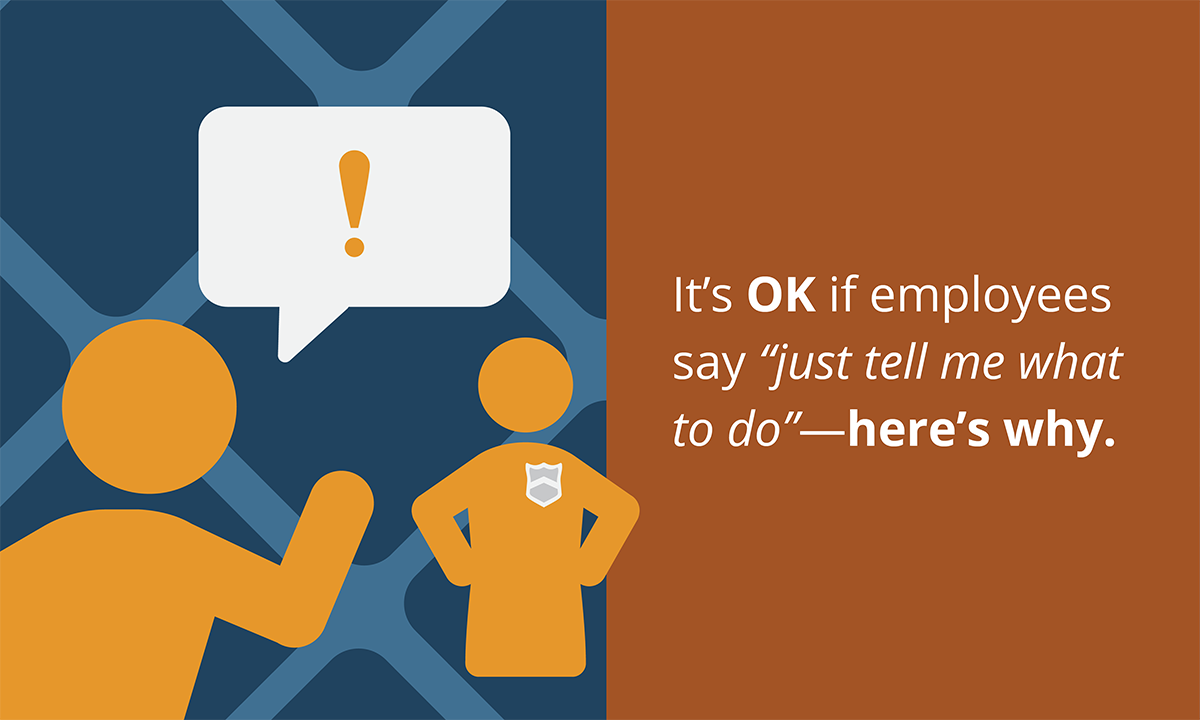
It’s OK if employees say “just tell me what to do”— here’s why.
You’ve done the work. You’ve put countless hours into crafting policies, training, and messaging to communicate the importance of compliance to your company. You’re getting good feedback from your peers when you compare notes and you’re optimistic that it’s really taking hold.
Until, that is, you go to an in-person engagement with a critical group of employees and hear those six dreaded words: “just tell me what to do.” 😨
Everyone who works in compliance has heard a story about this: employees don’t want to think about it, they just want to be told what to do so they can move on. And if your response to this situation is frustration, that’s pretty understandable—it’s only human to feel that way.
If your response is anxiety, though, that’s something different. It’s one thing to feel like employees don’t really get what you do; it’s another to worry that hearing “just tell me what to do” means your employees are waiting to run wild.
The truth is that you shouldn’t worry if you hear that; you should actually relax a little. Here’s why.
It means they’re willing to follow the rules—if someone will tell them how to do it.
When someone says "just tell me what to do," we can think that they don’t care about compliance and ethics at all. It seems to indicate that they don’t want to engage with it; they just want to get an answer and move on, and so it makes sense why we’d feel uncomfortable.
But does that really mean they don’t care about compliance?
Before you answer that, consider this: everyone does this. Including you.
 Yes, you. | Source: Netflix
Yes, you. | Source: Netflix
Think about one of your personal compliance obligations: income tax. When you file your taxes each year, do you read the regulations yourself? Do you dive deep into government guidance and think about underlying principles of equity and distribution? Do you set up email alerts for changes to the tax code to make sure you're ready for tax season?
No.
Instead, you use some tax preparation software or, if your taxes are a little more complicated, a tax preparer or accountant. Either way, you end up filling out some forms and handing over some documents and then waiting for them to tell you how much to pay.
That is, you ask them to tell you what to do.
Now, does that mean that you are unengaged or that you’re trying to cheat the government? Of course not. Saying “just tell me what to do” means that you are trying to meet your obligation but recognize you need help, because you're not a tax expert. You want to do the right thing, but you need someone to tell you what that is.
It's the same here. 💡 The fact that someone is asking you to "tell them what to do" does not mean that they do not care, just that they recognize that they don’t know what to do. The fact that they’re saying it means that they are willing to do the right thing; they just need to know what that is in this specific context. Don’t worry about these people—that’s a win.
The people you need to worry about are the ones who don’t ask for help. You need to worry about the ones who think that:
- if what they are doing is wrong, they probably won't get caught;
- if they do get caught, it will probably be much later; and
- if they do get caught much later they’ll just ask for forgiveness (assuming they haven’t already moved on to another job).
These folks will never say “just tell me what to do” because they’re gambling that it’s easier to simply avoid your team entirely and hope for the best. They’re the ones you need to worry about.
How to respond when someone says “just tell me what to do.”
OK, so someone says “just tell me what to do.” How do you respond? Sometimes the person is asking about a specific, well-defined issue where you can give a simple “yes/no.” Those ones are easy.
But sometimes you might worry that they’ll run with a “yes/no” answer and apply it in future scenarios where it’s not the right answer.
Or maybe they’re asking for more comprehensive advice so they don’t have to come back to you over and over again, but you’re worried that there’s no way you’re going to be able to cover everything without confusing them.
Those are reasonable worries, so let’s briefly address how to handle them. There are two meaningful options here.
First, you can refuse to answer or keep your advice deliberately vague; you’ve probably met someone at a conference or industry event who does this. It’s certainly an option, and it’s the right option if your goal is to make sure that your employees call you the “Department of No” behind your back. 🚫
Think of it this way: imagine that you went to your doctor with a medical concern and they refused to give you advice on how to handle it out of fear that you would apply it in the wrong circumstance. Instead, it was on you to come up with options for treatment, and the doctor’s role would be to keep telling you “no” until you came upon the right treatment plan.
Would you go back to that doctor again? Would you tell your friends to go see that doctor?
 🤷 | Source: 30 Rock
🤷 | Source: 30 Rock
That’s what it’s like when an employee asks you for guidance and you give them a vague answer, or no answer at all, telling them to figure it out and then requiring them to come back to you so you can approve or reject it. It is very unlikely you will ever hear from that employee again—not because they figured out the right answer, but because they figured out that going to you is simply not worth it.
So your second option, and a far better approach, is to recognize that for the vast majority of issues there are going to be:
(1) things that people can always or can never do,
(2) things that they can or can’t do under certain defined circumstances, or
(3) legitimately tough questions that need to be addressed case-by-case.
You can give people take-away guidance for #1 and #2, which makes it far more understandable (and less frustrating) when they have to come back for advice on #3. That is, if someone has to jump through hoops to get an answer—and having to stop their work to find time to talk to you and then wait for a response qualifies as a “hoop”—then their situation needs to be a little more complicated than a simple, obvious answer would cover.
You can create this take-away guidance in response to someone asking you for help in a specific circumstance, and you can also have a bunch of this kind of guidance ready-to-go on your intranet or compliance page to address common questions and concerns.
This type of guidance will often look like a decision tree, checklist, or chart that lets people handle all of the clear-cut cases on their own; it will also tell them when they don’t have a simple case and need to ask you for help (and plug: a lot of Broadcat’s products are exactly that). There are specific reasons you’d choose each format depending on the situation, but that’s another blog post; the key is that you just give them advice in a way that makes clear that you’re respecting their time by letting them handle the easy issues themselves.
In sum, someone who asks you to “just tell me what to do” is respecting you enough to ask for help in the first place, even if the way they’re articulating it isn’t the greatest. Respect them in how you respond by empowering them as much as possible. You can feel comfortable doing that because you know they want to do the right thing—that’s why they asked in the first place.

We couldn’t share a Ricardo blog post without
a sweet explosion gif. Classic. | 4GIFs.com via Giphy
Want another totally legit way to avoid those "just tell me what to do" questions? 😏 (NOT THAT YOU WANT TO AVOID THEM, WHICH WAS THE WHOLE POINT OF THIS POST!) Set up an ethics ambassadors program so that your employees have a local resource, too!

